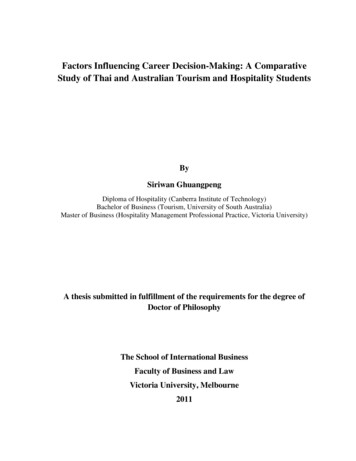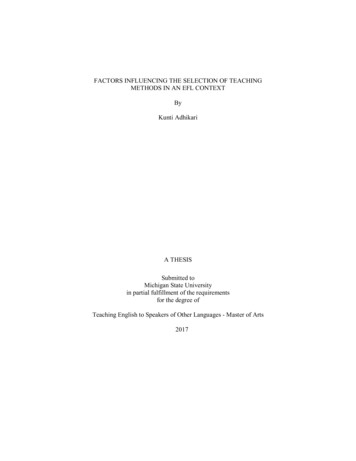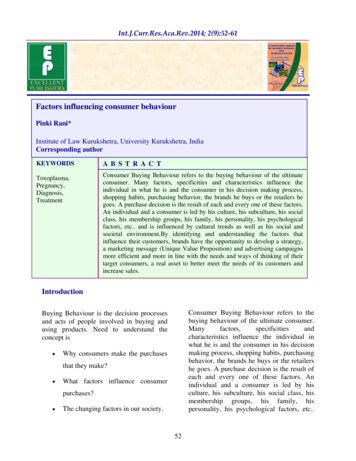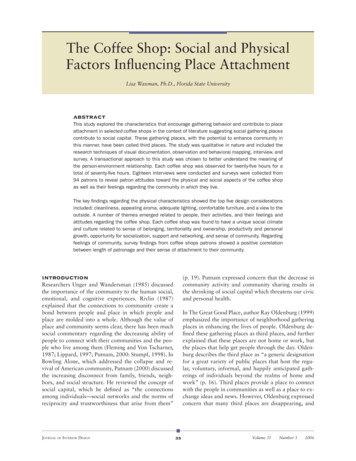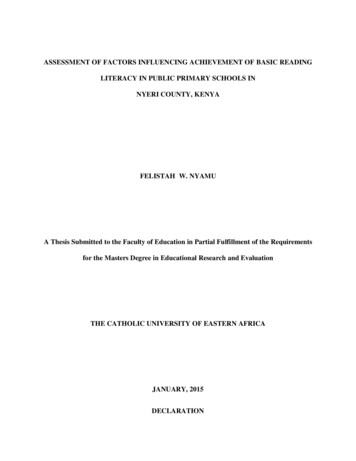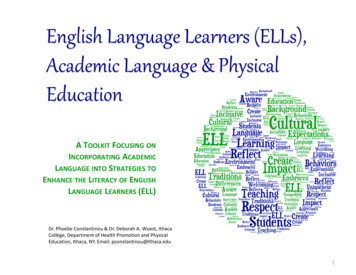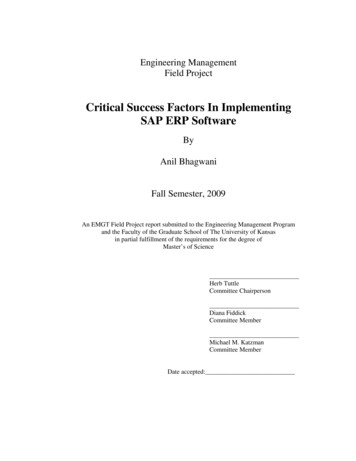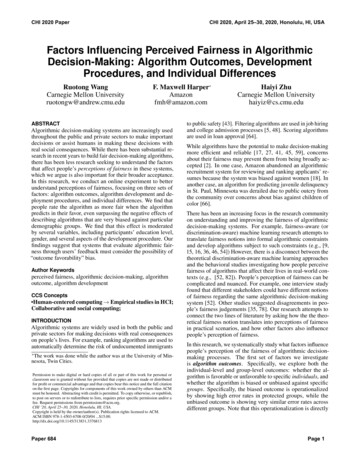
Transcription
CHI 2020 PaperCHI 2020, April 25–30, 2020, Honolulu, HI, USAFactors Influencing Perceived Fairness in AlgorithmicDecision-Making: Algorithm Outcomes, DevelopmentProcedures, and Individual DifferencesRuotong WangCarnegie Mellon Universityruotongw@andrew.cmu.eduF. Maxwell Harper Amazonfmh@amazon.comABSTRACTAlgorithmic decision-making systems are increasingly usedthroughout the public and private sectors to make importantdecisions or assist humans in making these decisions withreal social consequences. While there has been substantial research in recent years to build fair decision-making algorithms,there has been less research seeking to understand the factorsthat affect people’s perceptions of fairness in these systems,which we argue is also important for their broader acceptance.In this research, we conduct an online experiment to betterunderstand perceptions of fairness, focusing on three sets offactors: algorithm outcomes, algorithm development and deployment procedures, and individual differences. We find thatpeople rate the algorithm as more fair when the algorithmpredicts in their favor, even surpassing the negative effects ofdescribing algorithms that are very biased against particulardemographic groups. We find that this effect is moderatedby several variables, including participants’ education level,gender, and several aspects of the development procedure. Ourfindings suggest that systems that evaluate algorithmic fairness through users’ feedback must consider the possibility of“outcome favorability” bias.Author Keywordsperceived fairness, algorithmic decision-making, algorithmoutcome, algorithm developmentCCS Concepts Human-centered computing Empirical studies in HCI;Collaborative and social computing;INTRODUCTIONAlgorithmic systems are widely used in both the public andprivate sectors for making decisions with real consequenceson people’s lives. For example, ranking algorithms are used toautomatically determine the risk of undocumented immigrants* The work was done while the author was at the University of Minnesota, Twin Cities.Permission to make digital or hard copies of all or part of this work for personal orclassroom use is granted without fee provided that copies are not made or distributedfor profit or commercial advantage and that copies bear this notice and the full citationon the first page. Copyrights for components of this work owned by others than ACMmust be honored. Abstracting with credit is permitted. To copy otherwise, or republish,to post on servers or to redistribute to lists, requires prior specific permission and/or afee. Request permissions from permissions@acm.org.CHI ’20, April 25–30, 2020, Honolulu, HI, USA.Copyright is held by the owner/author(s). Publication rights licensed to ACM.ACM ISBN 978-1-4503-6708-0/20/04 . r 684Haiyi ZhuCarnegie Mellon Universityhaiyiz@cs.cmu.eduto public safety [43]. Filtering algorithms are used in job hiringand college admission processes [5, 48]. Scoring algorithmsare used in loan approval [64].While algorithms have the potential to make decision-makingmore efficient and reliable [17, 27, 41, 45, 59], concernsabout their fairness may prevent them from being broadly accepted [2]. In one case, Amazon abandoned an algorithmicrecruitment system for reviewing and ranking applicants’ resumes because the system was biased against women [18]. Inanother case, an algorithm for predicting juvenile delinquencyin St. Paul, Minnesota was derailed due to public outcry fromthe community over concerns about bias against children ofcolor [66].There has been an increasing focus in the research communityon understanding and improving the fairness of algorithmicdecision-making systems. For example, fairness-aware (ordiscrimination-aware) machine learning research attempts totranslate fairness notions into formal algorithmic constraintsand develop algorithms subject to such constraints (e.g., [9,15, 16, 36, 46, 54]) However, there is a disconnect between thetheoretical discrimination-aware machine learning approachesand the behavioral studies investigating how people perceivefairness of algorithms that affect their lives in real-world contexts (e.g., [52, 82]). People’s perception of fairness can becomplicated and nuanced. For example, one interview studyfound that different stakeholders could have different notionsof fairness regarding the same algorithmic decision-makingsystem [52]. Other studies suggested disagreements in people’s fairness judgements [35, 78]. Our research attempts toconnect the two lines of literature by asking how the the theoretical fairness notion translates into perceptions of fairnessin practical scenarios, and how other factors also influencepeople’s perception of fairness.In this research, we systematically study what factors influencepeople’s perception of the fairness of algorithmic decisionmaking processes. The first set of factors we investigateis algorithm outcomes. Specifically, we explore both theindividual-level and group-level outcomes: whether the algorithm is favorable or unfavorable to specific individuals, andwhether the algorithm is biased or unbiased against specificgroups. Specifically, the biased outcome is operationalizedby showing high error rates in protected groups, while theunbiased outcome is showing very similar error rates acrossdifferent groups. Note that this operationalization is directlyPage 1
CHI 2020 Paperaligned with the prevalent theoretical fairness notion in thefairness-aware machine learning literature, which asks for approximate equality of certain statistics of the predictor, suchas false positive rates and false-negative rates, across differentgroups.In addition to algorithm outcomes (i.e., whether an algorithm’s prediction or decision is favorable to specific individuals or groups), we also investigate development procedures(i.e., how an algorithm is created and deployed), and individual differences (i.e., the education or demographics of theindividual who is evaluating the algorithm). Specifically, weinvestigate the following research questions: How do (un)favorable outcomes to individuals and(un)biased treatments across groups affect the perceivedfairness of algorithmic decision-making? How do different approaches to algorithm creation and deployment (e.g., different levels of human involvement) affect the perceived fairness of algorithmic decision-making? How do individual differences (e.g., gender, age, race, education, and computer literacy) affect the perceived fairnessof algorithmic decision-making?To answer these questions, we conducted a randomized online experiment on Amazon Mechanical Turk (MTurk). Weshowed participants a scenario, stating “Mechanical Turk isexperimenting with a new algorithm for determining whichworkers earn for a Masters Qualification.” 1 We asked MTurkworkers to judge the fairness of an algorithm that the workerscan personally relate to. MTurk workers are stakeholders inthe problem, and their reactions are representative of laypeoplewho are affected by the algorithm’s decisions.In the description we presented to the participants, we includeda summary of error rates across demographic groups and adescription of the algorithm’s development process, manipulating these variables to test different plausible scenarios. Weincluded manipulation check questions to ensure that the participants understood how the algorithm works. We showedeach participant a randomly chosen algorithm output (either“pass” or “fail”), to manipulate whether the outcome would bepersonally favorable or not. Participants then answered several questions to report their perception of the fairness of thisalgorithmic decision-making process. We concluded the studywith a debriefing statement, to ensure that participants understood this was a hypothetical scenario, and the algorithmicdecision was randomly generated.We found that perceptions of fairness are strongly increasedboth by a favorable outcome to the individual (operationalizedby a “pass” decision for the master qualification), and by theabsence of biases (operationalized by showing very similarerror rates across different demographic groups). The effect ofa favorable outcome at individual level is larger than the effectof the absence of bias at group level, suggesting that solelysatisfying the statistical fairness criterion does not guaranteeperceived fairness. Moreover, the effect of a favorable or1 “Masters”workers can access exclusive tasks that are often associated with higher payments [57]).Paper 684CHI 2020, April 25–30, 2020, Honolulu, HI, USAunfavorable outcome on fairness perceptions is mitigated byadditional years of education, while the negative effect ofincluding biases across groups is exacerbated by describing adevelopment procedure with “outsourcing” or a higher level oftransparency. Overall, our findings point to the complexity ofunderstanding perceptions of fairness of algorithmic systems.RELATED WORK AND HYPOTHESISThere is a growing body of work that aims to improve fairness, accountability, and interpretability of algorithms, especially in the context of machine learning. For example,much fairness-aware machine learning research aims to buildpredictive models that satisfy fairness notions formalized asalgorithmic constraints, including statistical parity [25], equalized opportunity [36], and calibration [45]. For many of thesefairness measures there are algorithms that explore trade-offsbetween fairness and accuracy [4, 10, 26, 58]. For interpretinga trained machine learning model, there are three main techniques: sensitivity or gradient-based analysis [70, 47], building mimic models [37], and investigating hidden layers [8,82]. However, Veale et al. found that these approaches andtools are often built in isolation of specific users and user context [82]. HCI researchers have conducted surveys, interviews,and analyses on public tweets to understand how real-worldusers perceive and adapt to algorithmic systems [20, 21, 29,33, 51, 53]. However, to our knowledge, the perceived fairnessof algorithmic decision-making has not been systematicallystudied.Human Versus Algorithmic Decision-makingSocial scientists have long studied the sense of fairness inthe context of human decision-making. One key question iswhether we can apply the rich literature on the fairness ofhuman decision-making to the fairness of algorithmic decisionmaking.On one hand, it is a fundamental truth that an algorithm isnot a person and does not warrant human treatment or attribution [63]. Prior work shows that people treat these two typesof decision-making differently (e.g., [23, 50, 75]). For example, researchers describe “algorithm aversion,” where peopletend to trust humans more than algorithms even when the algorithm makes more accurate predictions. This is becausepeople tend to quickly lose confidence in a algorithm after seeing that it makes mistakes [23]. Another study pointed out thatpeople attribute fairness differently: while human managers’fairness and trustworthiness were evaluated based on the person’s authority, algorithms’ fairness and trustworthiness wereevaluated based on efficiency and objectivity [50]. On theother hand, a series of experimental studies demonstrated thathumans mindlessly apply social rules and expectations to computers [63]. One possible explanation is that the human brainhas not evolved quickly enough to assimilate the fast development of computer technologies [69]. Therefore, it is possiblethat research on human decision-making can provide insightson how people will evaluate algorithmic decision-making.In this paper, we examine the degree to which several factorsaffect people’s perception of fairness of algorithmic decisionmaking. We study factors identified by the literature on fair-Page 2
CHI 2020 Paperness of human decision-making — algorithm outcomes, development procedures, and interpersonal differences — as webelieve that they may also apply in the context of algorithmicdecision-making.Effects of Algorithm OutcomesWhen people receive decisions from an algorithm, they willsee the decisions as more or less favorable to themselves, andmore or less fair to others. Meta-review by Skitka et al. revealed that outcome favorability is empirically distinguishablefrom outcome fairness [77].Our first hypothesis seeks to explore the effects of outcome favorability on perceived fairness. Psychologists and economistshave studied perceived fairness extensively, particularly in thecontext of resource allocation (e.g., [7, 22, 56, 80]). Theyfound that the perception of fairness will increase when individual receive outcomes that are favorable to them (e.g., [80]).A recent survey study on 209 litigants showed that litigateswho receive favorable outcomes (e.g., a judge approves theirrequest) will perceive their court officials to be more fair andwill have more positive emotions towards court officials [40].Outcome favorability is also associated with fairness-relatedconsequences. Meta-analysis shows that outcome favorabilityexplains 7% of the variance in organizational commitment and24% of the variance in task satisfaction [77].Hypothesis 1a: People who receive a favorable outcome thinkthe algorithm is more fair than people who receive an unfavorable outcome.Social scientists suggest that people judge outcome fairness by“whether the proportion of their inputs to their outcomes arecomparable to the input/outcome ratios of others involved inthe social exchange” [77], often referred to as “equity theory”or “distributive justice” [3, 39, 83]. Contemporary theoristssuggest that distributive justice is influenced by which distributive norm people use in the relational context (e.g., [19, 55]),the goal orientation of the allocator (e.g., [19]), the resourcesbeing allocated (e.g., [76]), and sometimes political orientation(e.g., [56]). Empirical studies show that a college admissionprocess is perceived as more fair if it does not consider genderand if it is not biased against any gender groups [62]. Anotherstudy show that an organization will be perceived as less fairwhen managers treat different employees differently [49].In the context of algorithmic decision-making, one commonway of operationalizing equity and outcome fairness is “overallaccuracy equality”, which considers the disparity of accuracybetween different subgroups (e.g., different gender or racialgroups) [9]. The lower the accuracy disparity between different groups, the less biased the algorithm is. We hypothesizethat people will judge an algorithm to be more fair when theyknow it is not biased against any particular subgroups.Hypothesis 1b: People perceive algorithms that are not biased against particular subgroups as more fair.Prior literature provides mixed predictions regarding the relative effects of outcome favorability (i.e., whether individualsreceive favorable outcome or not) and outcome fairness (i.e.,whether different groups receive fair and unbiased treatments)Paper 684CHI 2020, April 25–30, 2020, Honolulu, HI, USAon the perceived fairness of the algorithm. A majority of theresearchers believe that individuals prioritize self-interest overfairness for everyone. Economists believe that people are ingeneral motivated by self-interest and are relatively less sensitive towards group fairness [72, 73]. Specifically, individualsare not willing to sacrifice their own benefits to pursue a groupcommon good in resource redistribution tasks [28]. A similarpattern has been found in the workplace. A survey of hotelworkers showed that people displayed the highest level ofengagement and the lowest rate of burnout when they wereover-benefited in their work, receiving more than they thinkthey deserved. In addition, people tend to justify an unequaldistribution when they are favored in that distribution [60].On the other hand, research also shows that people prioritizefairness over personal benefits in certain situations. For example, bargainers might be reluctant to benefit themselves whenit harms the outcomes of others, contingent on their socialvalue orientations, the valence of outcomes, and the settingwhere they negotiate [81]. In an analysis of presidential votechoices, researchers found that voters are more likely to votefor the president who will treat different demographic subgroups equally, independent of voters’ own group membership[61]. Whether the decision takes place in public or in privatehas a strong impact. In a study conducted by Badson et al., participants had to choose between allocation of resources to thegroup as a whole or to themselves alone. When the decisionwas public, the proportion allocated to the group was 75%.However, once the decisions became private, the allocation tothe group dropped to 30% [7].Algorithmic decisions are often private, not under the publicscrutiny. Therefore, we hypothesize that people will prioritizeself-interest when they react to the algorithm’s decisions. As aresult, the effect of a favorable outcome will be stronger thanthe effect of an unbiased treatment.Hypothesis 1c: In the context of algorithmic decision-making,the effect of a favorable outcome on perceived fairness islarger than the effect of being not biased against particulargroups.Effects of Algorithm Development ProceduresProcedural fairness theories concentrate on the perceived fairness of the procedure used to make decisions (e.g., [31]). Forexample, Gilliland examined the procedural fairness of theemployment-selection system in terms of ten procedural rules,including job relatedness, opportunity to perform, reconsideration opportunity, consistency of administration, feedback,selection information, honesty, interpersonal effectiveness ofadministrator, two-way communication, propriety of questionsand equality needs [34].Specifically, transparency of the decision-making process hasan important impact on the perceived procedural fairness. Forexample, a longitudinal analysis highlighted the importanceof receiving an explanation from the organization about howand why layoffs were conducted, in measuring the perceivedfairness of layoff decisions [84].In the context of algorithmic decision-making, transparencyalso influences people’s perceived fairness of the algorithms.Page 3
CHI 2020 PaperResearchers have shown that some level of transparency ofan algorithm would increase users’ trust of the system evenwhen the user’s expectation is not aligned with the algorithm’soutcome [44]. However, providing too much informationabout the algorithm might have the risk of confusing people,and therefore reduce the perceived fairness [44].Hypothesis 2a: An algorithmic decision-making process thatis more transparent is perceived as more fair than a processthat is less transparent.The level of human involvement in the creation and deployment of an algorithm might also play an important role indetermining perceptions of fairness. Humans have their ownbias. For example, sociology research shows that hiring managers tend to favor candidates that are culturally similar tothemselves, making hiring more than an objective process ofskill sorting [71].However, in the context of algorithmic decision-making, human involvement is often viewed as a mechanism for correcting machine bias. This is especially the case when peoplebecome increasingly aware of the limitation of algorithms inmarking subjective decisions. In tasks that require humanskills such as hiring and work evaluation, human decisionsare perceived as more fair, because algorithms are perceivedas lacking intuition and the ability to make subjective judgments [50]. The aversion to algorithmic decision-makingcould be mitigated when users contribute to the modificationof the algorithms [24]. Recent research on the developmentof decision-making algorithms has advocated for a humanin-the-loop approach, in order to make the algorithm moreaccountable [42, 68, 74, 86]. In sum, human involvement isoften considered as a positive influence in decision-makingsystems, due to the human’s ability to recognize factors thatare hard to quantify. Thus, it is reasonable to hypothesize thatpeople will evaluate algorithms as more fair when there arehuman insights involved in the different steps of the algorithmcreation and deployment.Hypothesis 2b: An algorithmic decision-making process thathas more human involvement is perceived as more fair than aprocess that has less human involvement.Effects of Individual DifferencesIn this research, we also investigate the extent to which theperceptions of algorithmic fairness are influenced by people’spersonal characteristics. Specifically, we look at two potentialinfluential factors: education and demographics.We first consider education. We believe both general educationand computer science education may influence perceptions offairness. People with greater knowledge in general and aboutcomputers specifically may simply have a better sense for whattypes of information an algorithm might process, and how thatinformation might be processed to come to a decision. We arenot aware of research that has investigated the link betweencomputer literacy and perceptions of fairness in algorithmicdecision-making, but research has investigated related issues.For example, prior work has looked at how people form “folktheories” of algorithms’ operation, often leading to incorrectnotions of their operation and highly negative feelings aboutPaper 684CHI 2020, April 25–30, 2020, Honolulu, HI, USAthe impact on their self interest [20]. We speculate that userswith greater computer literacy will have more realistic expectations, leading them to more often agree with the perspectivethat an algorithm designed to make decisions is likely to be afair process.Pierson, et al. conducted a survey of undergraduate studentsbefore and after an hour-long lecture and discussion on algorithmic fairness, finding that students’ views changed; inparticular, more students came to support the idea of usingalgorithms rather than judges (who might themselves be inaccurate or biased) in criminal justice [65]. This finding suggeststhat education, particularly education to improve algorithmicliteracy, may lead to a greater perception of algorithmic fairness.Hypothesis 3a: People with a higher level of education willperceive algorithmic decision-making to be more fair thanpeople with a lower level of education.Hypothesis 3b: People with high computer literacy will perceive algorithmic decision-making to be more fair than peoplewith low computer literacy.It is possible that different demographic groups have differentbeliefs concerning algorithmic fairness. Research has foundthat privileged groups are less likely to perceive problemswith the status quo; for example, the state of racial equalityis perceived differently by whites and blacks in the UnitedStates [14].There is a growing body of examples documenting algorithmicbias against particular groups of people. For example, ananalysis by Pro Publica found that an algorithm for predictingeach defendant’s risk of committing future crime was twice aslikely to wrongly label black defendants as future criminals,as compared with white defendants [6]. In another case, analgorithmic tool for rating job applicants at Amazon penalizedresumes containing the word “women’s” [18].There has been little work directly investigating the link between demographic factors and perceptions of algorithmicfairness. One recent study did not find differences betweenmen and women in their perceptions of fairness in an algorithmic decision-making process, but did find that men were morelikely than women to prefer maximizing accuracy over minimizing racial disparities in a survey describing a hypotheticalcriminal risk prediction algorithm [65].Based on the growing body of examples of algorithmic biasagainst certain populations, we predict that different demographic groups will perceive fairness differently:Hypothesis 3c: People in demographic groups that typicallybenefit from algorithmic biases (young, white, men) will perceive algorithmic decision-making to be more fair than peoplein other demographic groups (old, non-white, women).METHODTo test the hypotheses about factors influencing people’s perceived fairness of algorithmic decision-making, we conducteda randomized between-subjects experiment on MTurk. Thecontext for this experiment is a description of an “experimental”Page 4
CHI 2020 PaperCHI 2020, April 25–30, 2020, Honolulu, HI, USAalgorithmic decision-making process that determines whichMTurk workers are awarded a Master qualification.Algorithm Outcome: We explore two aspects of algorithmoutcome, (un)favorable outcome to individual and (un)biasedtreatment to group.Study platform (Un)favorable outcome: Participants randomly received adecision and were told the decision was was generated bythe algorithm. The decision (“pass” or “fail”) correspondsto either a favorable or an unfavorable outcome.MTurk is an online crowdsourcing workplace where over500,000 workers complete microtasks and get paid by requesters [13]. Masters workers are the “elite groups of workerswho have demonstrated accuracy on specific types of HITs onthe Mechanical Turk marketplace” [1]. Since Masters workerscan access exclusive tasks that are usually associated withhigher payments, the Master qualification is desirable amongMTurk workers [57].The Master qualification is a black-box process to workers.According to Amazon’s FAQs page, Mechanical Turk uses“statistical models that analyze Worker performance based onseveral Requester-provided and marketplace data points” todecide which workers are qualified [1].Experiment DesignManipulations Conditions Descriptions shown to participantsAlgorithm Outcome (H1)The algorithm has processed your HIT history,(Un)favorable Favorableand the result is positive (you passed the Master qualification test).OutcomeThe algorithm has processed your HIT history,Unfavorableand the result is negative (you did not pass the Master qualification test).Percent errors by gender: Male 2.6%, Female 10.7%Percent errors by age: Above 45 9.8%, Between 25 and 45 3.6%, Below 25 1.2%(Un)biasedBiasedPercent errors by race: White 0.7%, Asian 6.4%, Hispanic 5.8%,TreatmentNative American 6.7%, Other 14.1%Percent errors by gender: Male 6.4%, Female 6.3%Percent errors by age: Above 45 6.4%, Between 25 and 45 6.2%, Below 25 6.5%UnbiasedPercent errors by race: White 6.5%, Asian 6.4%, Hispanic 6.4%,Native American 6.5%, Other 6.2%Algorithm Creation and Deployment (H2)The organization publishes many aspects of this computer algorithm on the web,including the features used, the optimization process, and benchmarksHighTransparencydescribing the process’s accuracy.The organization does not publicly provide any informationLowabout this computer algorithm.The algorithm was built and optimized by a team of computer scientistsCS Teamwithin the organization.DesignThe algorithm was outsourced to a company that specializesOutsourcedin applicant assessment softwareThe algorithm was built and optimized by a team of computer scientistsCS and HRand other MTurk staff across the organization.MachineThe algorithm is based on machine learning techniques trained to recognizeLearningpatterns in a very large dataset of data collected by the organization over timeModelThe algorithm has been hand-coded with rules provided byRulesdomain experts within the organization.The algorithm’s decision is then considered on a case-by-case basis byMixedMTurk staff within the organization.DecisionAlgorithmThe algorithm is used to make the final decision.-only (Un)biased treatment: In both conditions, participantswere shown tables of error rates across demographic groups(see Figure 1). In the unbiased condition, participants sawvery similar error rates across different demographic groups,which (approximately) satisfies the fairness criterion of“overall accuracy equality” proposed by Berk et al. [9];in the biased condition, participants saw different error ratesacross different groups (we used error rates from a real computer vision algorithm from a previous study [12]), whichviolates the same statistical fairness criterion.Algorithm Development Procedure: We also manipulatedthe transparency and level of human involvement in the algorithm creation and deployment procedure. Participants wereshown a description of the algorithm corresponding to theirrandomly-assigned conditions. The specific text of each condition is shown in Table 1.Table 1: Summary of the experimental manipulationsshown to participants.Figure 1: Overview of the procedure of the experiment foreach participant.We designed an online between-subjects experiment in whichparticipants were randomly assigned into a 2 (biased vs. unbiased treatment to groups) 2 (favorable vs. unfavorableoutcome to individuals) 2 (high vs. low transparency) 3(outsourced vs. computer scientists vs. mixed design team) 2 (machine learning vs. expert rule-based model) 2(algorithm-only vs. mixed decision) design. These manipulations allow us to test the effects of algorithm outcome onperceived fairness (Hypothesis 1) and the effects of algorithmdevelopment procedures on perceived fairness (Hypothesis 2).We asked participants to provide their demographic information, which allows us to test Hypothesis 3. The experimentdesign and manipulations are summarized in Table 1.The experiment consisted of five steps, as shown in Figure 1.Paper 684ProcedureStep 1. Participants were shown information about the algorithm in two parts. The first part provided details about thealgorithm development and design process. We created 24(3 2 2 2) different variations for this part, manipulating thefour aspects of algorithm development (transparency, design,model, and decision). The second part of the description is atable of error rates across different demographic subgroups.The error rates are either consistent or differentiated acrossgroups. Participants were required to answer quiz q
the context of human decision-making. One key question is whether we can apply the rich literature on the fairness of human decision-making to the fairness of algorithmic decision making. On one hand, it is a fundamental truth that an algorithm is not a person and does not warrant human treatment or attribu-
